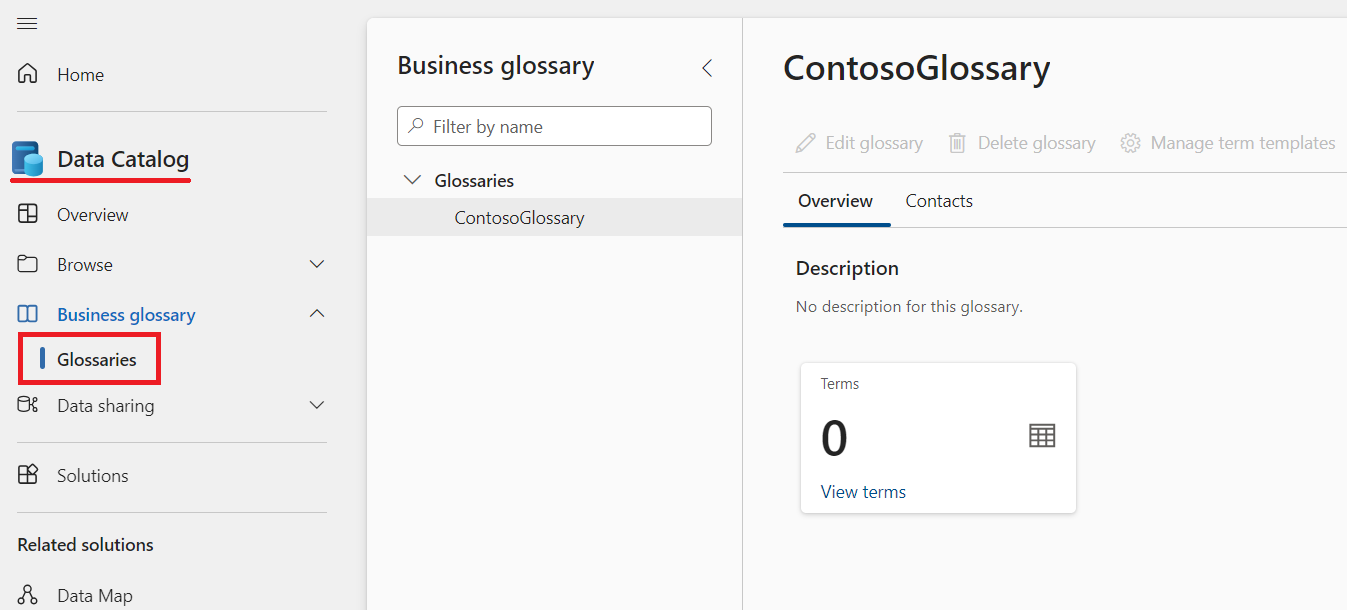Understand business glossary features in the classic Microsoft Purview governance portal
Tip
Microsoft Purview has a new experience! If you're a new Microsoft Purview customer, or if you want more information, see our article on the new portal or the article about our new data governance experience and our new glossary terms.
A glossary provides vocabulary for business users. It consists of business terms that can be related to each other and allows them to be categorized so that they can be understood in different contexts. These terms can be then mapped to assets like a database, tables, columns etc. This helps in abstracting the technical jargon associated with the data repositories and allows the business user to discover and work with data in the vocabulary that is more familiar to them.
You can find Microsoft Purview's classic glossaries in the classic Microsoft Purview governance portal in the Data Catalog under Business Glossary.

A business glossary is a collection of terms. Each term represents an object in an organization and it's highly likely that there are multiple terms representing the same object. A customer could also be referred to as client, purchaser, or buyer. These multiple terms have a relationship with each other. The relationship between these terms could be:
- synonyms - different terms with the same definition
- related - different name with similar definition
The same term can also imply multiple business objects. It's important that each term is well-defined and clearly understood within the organization.
Custom attributes
Microsoft Purview supports these out-of-the-box attributes for any business glossary term:
- Name (mandatory)
- Nickname
- Status
- Definition
- Stewards
- Experts
- Resources
These attributes can't be edited or deleted, but only the Name is mandatory to create a glossary term. However, these attributes aren't sufficient to completely define a term in an organization. To solve this problem, Microsoft Purview provides a feature where you can define custom attributes for your glossary.
Relationships between terms
Microsoft Purview supports these out-of-the-box relationships for terms:
- Parent/child term
- Acronym
- Synonyms
- Related terms
Relationship definitions in the glossary are bi-directional: Every relationship between terms is a two-way relationship. This means that if term A is related to term B, then term B is also related to term A.
Anytime you populate a relationship in one direction, Purview automatically adds the reverse relationship for you. For example, if you add term A as a synonym for term B, Purview automatically adds term B as a synonym for term A.
Term templates
Term Templates provides glossary custom attributes to be logically grouped together in catalog. The feature allows you to group all the relevant custom attributes together in a template and then apply the template while creating the glossary term. For example, all finance- related custom attributes like cost center, profit center, accounting code can be grouped in a term template Finance Template and the Finance template can be used to create financial glossary terms.
All the standard attributes are grouped in a system default template. Any term template that you create will contain these attributes along with any more custom attributes created as part of template creation process.
Glossary vs classification vs sensitivity labels
While glossary terms, classifications and labels are annotations to a data asset, each one of them has a different meaning in the context of catalog.
Glossary
As stated above, Business glossary term defines the business vocabulary for an organization and helps in bridging the gap between various departments in your company.
Classifications
Classifications are annotations that can be assigned to entities. The flexibility of classifications enables you to use them for multiple scenarios such as:
- understanding the nature of data stored in the data assets
- defining access control policies
Microsoft Purview has more than 200 system classifiers today and you can define your own classifiers in catalog. As part of the scanning process, we automatically detect these classifications and apply them to data assets and schemas. However, you can override them at any point of time. The human overrides are never replaced by automated scans.
Sensitivity labels
Sensitivity labels are a type of annotation that allows you to classify and protect your organization's data, without hindering productivity and collaboration. Sensitivity labels are used to identify the categories of classification types within your organizational data, and group the policies that you wish to apply to each category. Microsoft Purview makes use of the same sensitive information types as Microsoft 365, which allows you to stretch your existing security policies and protection across your entire content and data estate. The same labels can be shared across Microsoft Office products and data assets in Microsoft Purview.
For more information about sensitivity labels, see: Learn about sensitivity labels
Next steps
Feedback
Coming soon: Throughout 2024 we will be phasing out GitHub Issues as the feedback mechanism for content and replacing it with a new feedback system. For more information see: https://aka.ms/ContentUserFeedback.
Submit and view feedback for